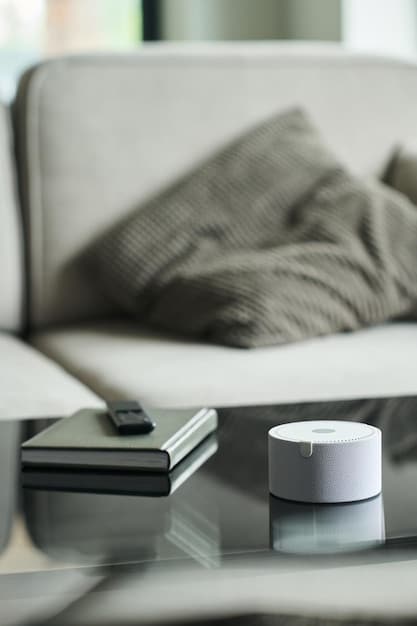Ease Anxiety: Creating a Calm Smart Home Environment

Is your smart home increasing your anxiety? Learn how to mitigate the stress of interconnected devices and cultivate a peaceful, user-friendly living space by employing mindful tech integrations and thoughtful configuration adjustments.
The promise of a smart home is convenience and control, but for many, the reality is a constant barrage of notifications, overwhelming options, and a creeping sense of unease. Let’s explore how to transform your smart home from a source of stress into a sanctuary of calm.
Understanding Smart Home Anxiety
Smart homes are designed to simplify our lives, automating tasks and providing information at our fingertips. However, the constant connectivity and potential for system failures can lead to a unique form of anxiety. Understanding the root causes is the first step in creating a more peaceful environment.

The Notification Overload
One of the biggest culprits of smart home anxiety is the sheer volume of notifications. Each device vying for our attention can create a sense of overwhelm.
Fear of System Failure
Smart homes rely on interconnected systems, and the fear of something going wrong – a security breach, a power outage, or a simple software glitch – can be a constant source of worry.
- Set clear boundaries: Designate specific times for checking smart home data and avoid constant monitoring.
- Prioritize essential notifications: Disable alerts that are not critical to security or safety.
- Regularly update your systems: Keep your software and firmware up-to-date to minimize vulnerabilities.
By recognizing these common sources of anxiety, we can begin to address them proactively, tailoring our smart homes to enhance our well-being rather than detract from it. Start by identifying the specific aspects of your smart home that cause you the most stress and then implement strategies to mitigate those issues.
Decluttering Your Digital Space
Just as physical clutter can contribute to anxiety, so too can digital clutter. Streamlining your smart home setup and removing unnecessary devices and features can significantly reduce stress.
Assess Your Needs
Take a critical look at your smart home devices and ask yourself: Do I really need this? Are there features I never use?
Simplify Automation Routines
Complex automation routines can be confusing and difficult to troubleshoot. Stick to simple, well-defined routines that address your core needs.

- Unplug unnecessary devices: If you’re not using a device regularly, consider unplugging it to conserve energy and reduce potential security risks.
- Consolidate apps: Use a central smart home hub to control multiple devices from a single interface.
- Re-evaluate subscriptions: Cancel any smart home service subscriptions that you no longer use.
Decluttering your digital space is an ongoing process. Regularly review your smart home setup and make adjustments as your needs evolve. Remember, the goal is to create a streamlined, efficient system that enhances your life without adding unnecessary complexity.
Creating Mindful Automation
Automation can be a powerful tool for reducing stress, but it’s important to use it mindfully. By designing automation routines that align with your values and priorities, you can create a smart home that supports your well-being.
Focus on Essential Tasks
Identify the tasks that cause you the most stress or take up the most time. These are the areas where automation can be most beneficial.
Design for Well-Being
Incorporate elements of mindfulness into your automation routines. For example, you could schedule your smart lights to gradually dim in the evening, signaling your body to prepare for sleep.
- Automate security: Set up automated security routines, such as locking doors and arming alarms at night, to provide peace of mind.
- Optimize energy usage: Use smart thermostats and lighting controls to reduce energy consumption and lower your carbon footprint.
- Personalize your environment: Create custom scenes that adjust lighting, temperature, and music to create the perfect atmosphere for relaxation or productivity.
Mindful automation is about using technology to enhance your well-being, not to replace human connection or individual control. Take the time to design automation routines that truly support your needs and values, and be willing to adjust them as your life changes.
Optimizing Your Smart Home for Sleep
Sleep is essential for both physical and mental health. Your smart home can play a key role in creating a sleep-conducive environment.
Regulate Light Exposure
Smart lights can be programmed to mimic the natural light cycle, gradually dimming in the evening to promote melatonin production and waking you up gently in the morning.
Control Temperature and Humidity
Smart thermostats can maintain a consistent temperature throughout the night, while smart humidifiers can help to regulate humidity levels.
- Create a bedtime routine: Set up a series of automated tasks that occur each night before bed, such as dimming the lights, playing calming music, and locking the doors.
- Block out distractions: Use smart blinds or curtains to block out external light and noise.
- Monitor your sleep: Use a sleep tracker to gain insights into your sleep patterns and identify areas for improvement.
By optimizing your smart home for sleep, you can create a sanctuary that supports restful sleep and promotes overall well-being. Remember that consistency is key, so stick to a regular sleep schedule and avoid using electronic devices in bed.
Enhancing Security Without Increasing Anxiety
Smart home security systems offer peace of mind, but they can also be a source of anxiety if not managed properly.
Choose Reputable Brands
Invest in security devices from reputable brands with a proven track record of security and privacy.
Strengthen Your Network Security
Secure your Wi-Fi network with a strong password and enable two-factor authentication whenever possible.
- Regularly update your firmware: Keep your security devices up-to-date with the latest firmware to patch any vulnerabilities.
- Monitor your system regularly: Check your security logs and activity reports for any suspicious activity.
- Educate yourself: Stay informed about the latest security threats and best practices for protecting your smart home.
By taking these steps, you can minimize the risk of security breaches and enjoy the peace of mind that comes with knowing your home is protected. Remember that security is an ongoing process, so stay vigilant and adapt your strategies as needed.
Finding the Right Balance
The key to a calm and connected smart home is finding the right balance between convenience, control, and simplicity. It’s about leveraging technology to enhance your life without letting it overwhelm you.
Regularly Reassess Your Setup
Your needs and preferences will change over time, so it’s important to reassess your smart home setup regularly.
Prioritize Well-Being
Never let technology compromise your physical or mental health. If you find yourself feeling overwhelmed or stressed by your smart home, take a step back and make adjustments.
- Create Technology-Free Zones: Designate specific areas in your home, such as the bedroom or dining room, as technology-free zones where you can disconnect and relax.
- Set Time Limits: Use app timers to limit your usage of certain smart home features or devices.
- Practice Mindfulness: Take short breaks throughout the day to disconnect from technology and focus on your breath or surroundings.
By finding the right balance, you can create a smart home that truly supports your well-being and enhances your quality of life. It’s about using technology mindfully and intentionally, rather than letting it control you.
| Key Point | Brief Description |
|---|---|
| 🧘♀️ Reduce Notifications | Limit unnecessary alerts to decrease overwhelm. |
| 🔒 Secure Your Network | Protect your smart home with strong passwords and updates. |
| 💡 Mindful Automation | Use technology to support well-being intentionally. |
| 🌙 Optimize Sleep | Create a sleep conducive environment with smart devices. |
Frequently Asked Questions
▼
Start by minimizing notifications, securing your network, and automating tasks mindfully. Limit alerts, use strong passwords, and design automations that truly improve your life.
▼
Mindful automation helps you use technology intentionally, reducing stress and promoting well-being. It allows you to focus on what truly matters, enhancing your quality of life.
▼
Smart lights, thermostats, and humidifiers can create a sleep-conducive environment. Regulate light exposure, control temperature, and automate your bedtime routine for better sleep.
▼
Choose reputable brands, strengthen your network security, and regularly update firmware. Monitor your system, educate yourself, and balance security with simplicity.
▼
Finding the right balance between convenience, control, and simplicity is key. Reassess your setup, prioritize well-being, and create technology-free zones for a more peaceful environment.
Conclusion
Transforming your smart home into a source of calm requires mindful integration, thoughtful configuration, and a commitment to prioritizing your well-being. By understanding the causes of smart home anxiety and implementing practical strategies, you can create a connected environment that truly enhances your life.





